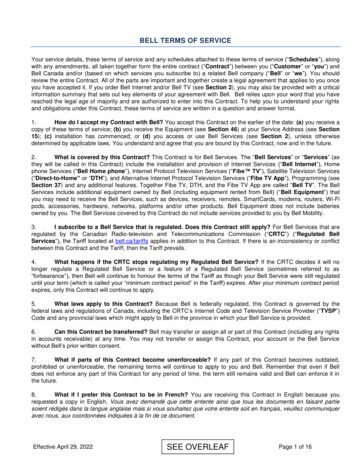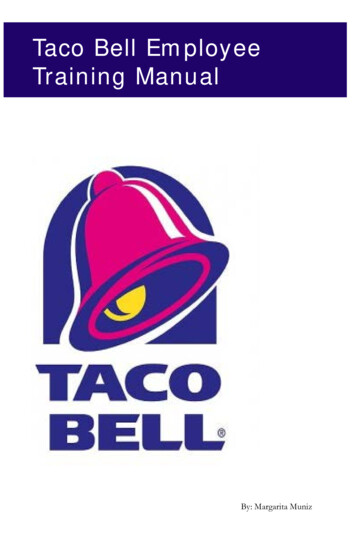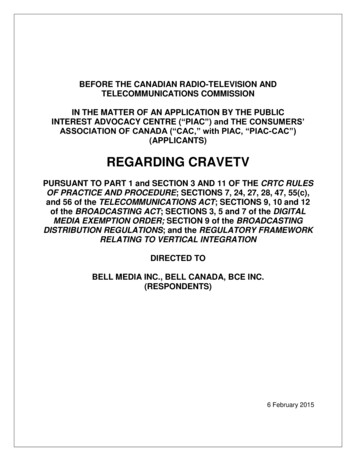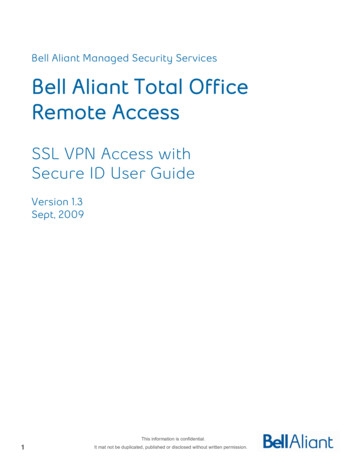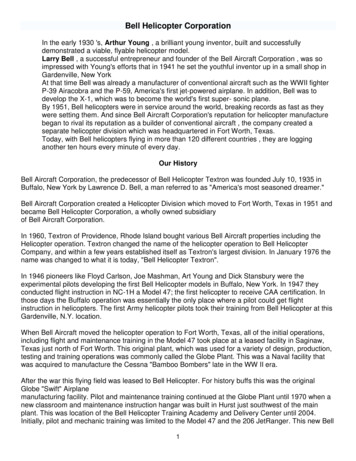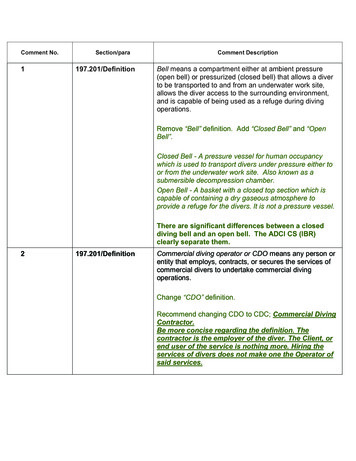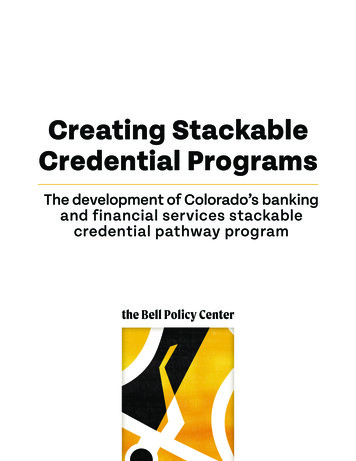
Transcription
1
Authors:Nazia Hasan Policy AnalystDesiree Collins MSW InternContributors:Laura Valle Gutierrez Senior Policy AnalystIsaac Burton Visual Communications SpecialistAcknowledgements:Thank you to Mi Casa Resource Center and Lumina Foundation for funding this work. The Bell Policy Center would alsolike to express thanks to the banking and financial servicesstackable credentials pathway design team, including staffand leadership from Mi Casa Resource Center, Community College of Aurora, and Metropolitan State University ofDenver. The design team met with the Bell’s policy and research team to share insights on its process and learning thattook place during the development of the program. The Bell isthankful for additional feedback on the design process fromSkillful, Denver Education Attainment Network, and ColoradoDepartment of Higher Education.www.bellpolicy.org2
There are many unknowns when it comes to the future of work. Automation, technologicaladvances, and shifting demands in our economy mean there are jobs that are being displaced and jobs that don’t even exist yet. One further challenge feeding into this changingand uncertain future is a workforce that may lack skillsets aligned to the demands of anew landscape. Without paying special attention to equity of access and existing barriers,policymakers and education institutions run the risk of creating a workforce that is unableto meet the demands of the day.Today, too many students face barriers that make it difficult to complete and attain acredential that is relevant to a career path that will have opportunities for advancementand yield a positive return on investment. These barriers include: The high costs of training programs and postsecondary education Misalignment between coursework and curriculum that may not meet industryneeds and long-term opportunities Significant time burdens in attaining different credentials and degreesIt is in addressing this complex nexus of issues the stackable credentials program —championed by Mi Casa Resource Center, the Community College of Aurora, MetropolitanState University of Denver, and members of the financial services industry — emerged asa powerful tool to ensure students have the opportunity to gain the skills and credentialsneeded to meet the demands of growing industries. In Colorado, these organizations, ledby the financial services industry’s need for a better talent pipeline, convened to developa program wherein the skills gained from one partner organization translated directly intoprerequisites for another.A stackable credentials program: Offers a defined career pathway that allows for individuals to advance within theindustry by building off previous experience or formal credentials Allows students to enter at different points, but also enables minimally entering theprogram with an entry-level position with a livable wage Ensures previous experience and trainings lead directly to credit within the next tierof education and to desired skills for employers3
To build the larger banking and financial services stackable credential program, the partnersfocused on three main components: Prioritizing addressing equity barriers in the design and implementation Developing strong partnerships that include strong industry representation Utilizing existing structures, such as existing curriculum and credential programsThrough these components, the program was able to remedy existing inefficiencies and optimize a pathway to best meet the needs of students. One key example was using prior learningassessments (PLAs) to give students credit for past work experiences. This tool was alreadyused by the institutions of higher education, allowing students to reduce the cost and time ittakes to receive a credential. The pathway program also includes many “on- and off-ramps,”offering students the flexibility to gain skills and attain a credential that would leads to advancement, without having to sink costs only to partially complete a program without gaininga credential or translatable skills.At its core, the program recognizes the many different ways learning can and does occur. Thepartners convened with a shared goal of recognizing the value of different ways of learning allfor the purpose of creating a robust talent pipeline for the development of Colorado’s workforce.Partnership between different organizations was critical for the success of this program. Ensuring the coursework at one institution aligned to the skills being taught at another was theresult of iterative engagement and reflection. While innovative partnerships are a prerequisitefor success, the stackable credentials program can easily be translated to other settings.While this study outlines the steps taken in the financial services stackable credentials program, the lessons learned are transferable across a number of industries. Regardless thecircumstance, honoring past experiences, reducing costs, and a commitment to partnershipare critical to both the success of the program and fidelity of implementation. As Coloradostrives to meet the demand for future jobs and ensure our future is more equitable than today,programs like stackable credentials have significant potential to help prepare our communitiesfor good jobs that will be in high demand.Recognizing the demand for skilled workers in the banking and financial industries talentpipeline, Mi Casa Resource Center (MCRC), the Community College of Aurora (CCA), and theMetropolitan State University of Denver (MSU Denver) partnered to create a unique stackablecredentials pathway (SCP) program for the banking and financial services industry.This publication captures their design process and learnings essential to implementing a sustainable stackable credential pathway for any industry or geographic region. The banking andfinancial services industry pathway is an example of a model that could be applied to multipleissue areas such as early childhood education and health care. The lessons from this pathwayoffers guidance to those thinking about replication.4
Stackable Credentials PathwayFor too many businesses and students, the currentworkforce development and postsecondary systemsare not working. The trainings, certificates, and degrees available often do not translate into the skillsbusinesses need from their employees. Too often, students are not able to build upon their existing skillsand have to start over with each education institution.Credentials, such as degrees or training certificates,are now a prerequisite for most good jobs, yet the roadto these certificates and a college degree is expensiveand complicated. 1 For those who do earn their degrees, they may find themselves in a situation wheretheir degree does not translate to the skills neededby employers.The SCP program is one promising solution to thisproblem: It builds upon industry demand and expertiseand streamlines advancement opportunities betweenmultiple workforce development and postsecondaryeducation institutions. In short, a stackable credentials pathway is the sequencing of postsecondarycredentials that can be accumulated over time andhelp individuals develop qualifications to move alonga career ladder or higher paying jobs.2For students, stackable credentials address multiplebarriers that keep students from attaining relevantcertificates and degrees in a timely way and at a lowercost. Instead of focusing on a skills gap, the programfocuses on how to build upon the existing skills of individuals. Through extensive partnerships, studentscan translate their existing skills into credits, resultingin less time and costs to attain the next level of credential or degree.For business, the demand-driven nature and strongbusiness partnership embedded within stackable credentials ensures businesses have a direct recruitmentpipeline of employees who have the skills they needfor positions at all levels.The banking and financial services stackable credential program created a career pathway that providesstudents with many on and off ramps within the in5Banking and FinancialServices StackableCredentials Pathway:Strengthens collaboration between communitytrainers with two-yearand four-year postsecondary education institutions.Engages industry atevery step to ensurealignment between education and workforce.Encourages skills-basedhiring by recognizingcompetencies throughshorter term credentialsthat can be stacked intoadditional associates orbachelor’s degree overtime.Reduces time and cost ofcredentials by recognizing prior work experienceas valuable to formalpostsecondary education.Provides flexibilitythrough multiple on andoff ramps to students.
dustry. Jobseekers start by taking a financial services training connected to employmentand college credit simultaneously. By enrolling in the class, they are guaranteed three jobinterviews with employers and the opportunity to earn nine college credits. These creditsstack into a certificate program at Community College of Aurora and those credits thenstack into a new B.S. in banking degree at MSU Denver, a local four-year institution.Banking Career PathwaysStudentCurrentBankingEmployee 2020 Metropolitan State University of Denver. All rights reserved. Published March ificateSupervisionFundamentalsCertificateMSU DenverB.S. BankingDegreePriorLearningCreditNeed for Postsecondary EducationResearchers at Georgetown University project 65 percent of all jobs will require some form ofpostsecondary education or training as early as 2020.3 Currently, 57 percent of Colorado’sworkforce has attained a postsecondary credential, but one-third of Colorado’s adult population lacks education beyond high school.4 Furthermore, only 32 percent of Latinx Coloradans,the primary demographic served by the program partners in Colorado, have postsecondarycredentials.While not all jobs in Colorado require postsecondary credentials, 67 percent of the state’s topjobs or jobs with living wages and industry growth require credentials beyond a high schooldegree.5,6 Accessing jobs with living wages is a challenge for adults and communities of colorlacking postsecondary credentials that meet job requirements. These challenges also existfor approximately 400,000 adults in Colorado’s workforce who have some postsecondaryeducation, but not the credential needed to meet many job requirements.76
Colorado 2018 PostsecondaryCredential AttainmentPromising solutions tailored to meetthe needs of adults and communities of color without credentialsare critical to adequately preparefor Colorado’s workforce demands.Combining their deep institutionalcommitment to equity, MCRC, CCA,and MSU Denver partnered to builda stackable credentials pathwayspecifically tailored to the needs oflow-income, adult learners of color.Mi Casa Resource Center (MCRC)Mi Casa educates and provides career and business developmentto support job seekers and business owners to advance towardseconomic self-sufficiency. Seventy-five percent of their participants are Hispanic and/or Latino, 80 percent are women, and 92percent have low incomes.Community College of Aurora (CCA)The Community College of Aurora is a designated Hispanic-serving institution and a recognized leader in Colorado’s postsecondary education space. Known for its cultural competenceand innovation, nearly 32 percent of CCA’s student populationidentifies as Hispanic and/or Latino.Metropolitan State University of Denver (MSU Denver)MSU Denver is a designated Hispanic-serving institution and isknown for serving students from diverse socioeconomic backgrounds. MSU Denver’s undergraduate student body makeupis 46 percent students of color and 56 percent first-generationstudents.Why Partner with the Banking IndustryA central component of the banking and financial services SCP design is a focus on equityand inclusion to better support adult learners of color to gain entry into or advance withinthe financial services industry. The focus on these students was partly because they havebeen left out of traditional models or existing programs, and because all the partner organizations had a mission-driven interest in serving these students. Because the bankingand finance industry needed to increase the supply of skilled workers in many areas that7
do not require a four-year degree, it offered strong potential. Critically, jobs in the financial services industry have opportunities for advancement and growth, addressing a keyequity barrier that many adult learners face. According to the Colorado Talent PipelineReport, the banking and financial industry was identified as an industry with projectedgrowth in jobs and median earnings above livable wages.8Further, the financial services industry was crucial as an initial convener, and strongpartner in the development of this program. Industry partners approached MSU Denver,citing the need for students with skillsets that were aligned to the demands of the job. Thisallowed partners to use the entry points in the banking and financial services industry asa starting point in the SCP design and build additional credentials that aligned with theindustry’s career ladder. Through a demand-driven approach and the continual engagement of the banking and finance industry during every step of the process, the programpartners were able to ensure that they were creating opportunities for students thattranslated into actual careers and employees that had skills that matched business needs.Ultimately, this alignment between student and industry needs drove the collaborationto develop an innovative pathway that put both these interests first.Core ComponentsThe Bell Policy Center in partnership with MCRC, CCA, and MSU Denver conducted interviews with the banking and financial services SCP program design team to capturethe learnings and elements of the design. The SCP design team included leadership andprogram staff from all three partner organizations who were involved in the design process. Through these interviews, three core components of SCP design were identified asessential to the SCP model. The core components of the banking and financial servicesSCP design include:1. Centering equity and inclusion to eliminate barriers to postsecondary and workforce success2. Engaging employer partners and having an intentional focus on including industryvoice in all phases of the design process3. Convening innovative education and workforce partners to reconfigure existingprograms to build pathways that meet employer expectations, student needs, andColorado’s policy priorities.Core Component: Centering Equity & Inclusion to Eliminate Barriersto Postsecondary & Workforce SuccessAdult learners (also referred to as “nontraditional” students) are commonly identified bytheir age and enrollment status. Nontraditional students are also characterized by delayedpostsecondary enrollment, part-time attendance, full-time work status (35 hours or moreper week), financial independence, having a dependent, being a single parent, or lack of ahigh school diploma.9 Based on these characteristics and by meeting at least one criterion,three-quarters of Colorado students in postsecondary institutions are nontraditional students.8
Compared to students who enroll in postsecondary education programs immediately out of highschool, adult learners face significantly differentbarriers to postsecondary education success.There are four primary barriers adult learners face: Lack of time to pursue education Family responsibilities Course times and locations, Cost of postsecondary education.10Colorado Studentsin PostsecondaryInstitutions Recognizing the specific barriers facing adultlearners, the SCP design team developed solutionsthat allow for greater affordability and flexibility,addressing two key equity barriers. 26% are parents38% are older than 2543% are part-time students76% work more than 20 hoursper week while enrolled inpostsecondary educationprogram87% live off campusAffordabilityTo reduce the cost barriers facing adult learners, the program partners selected an industrywith entry-level wages that allowed for employment while taking classes, ensured creditfor prior learning experiences is available, and provided financial assistance at every levelof credit programming.Connecting adult learners to employment opportunities early within the program wasessential to reducing financial burdens.Building upon the existing assets and skills of participants, the program also addresses thecost burdens of postsecondary education by creating formal mechanisms for participantsto receive credit for skills and experiences attained outside of traditional institutionalsettings. A majority of MCRC’s participants entered their programs with experience in theretail sector and were looking for careers in professional settings, family-friendly hours,benefits, and higher wages. There was, therefore, a natural alignment between adult learners’ existing skillset and entry-level jobs in the banking and financial services sector.These skills were formalized into educational credits through the use of prior learning assessments (PLAs), which provided credit for past skills and knowledge acquired in work orother non-postsecondary settings.11 Students benefit from PLAs by testing out of requiredcourses which ultimately save students time and the cost of the course, reducing the financial burden. Multiple PLA assessment options are available for Colorado’s postsecondaryinstitutions to assess prior training and competencies for college credit, such as: Standardized exams: tests that are nationally recognized, like the College Board College-Level Examination Program (CLEP) Institutional challenge exams: exams created by faculty which assess the students’knowledge of the competencies taught in the challenged course9
Published guides: nationally approved workforce training programs like the AmericanCouncil on Education (ACE) National Guide to College Credit for Workforce Training, or“locally evaluated industry and workplace certifications and training” 12 Faculty-evaluated local industry and workplace credit: a process in which faculty canevaluate an industry or business provided training for PLA credit Portfolio assessment: a combination of professional artifacts a student has collectedthat validate the student’s mastery of the competencies taught in the challenged course 13In addition to PLAs, MCRC, CCA, and MSU Denver each allocated scholarship fundingopportunities available to program participants. The programs partners also ensuredadult learners could access additional financial support through federal financial aid andworked with students to fill out applications.FlexibilityAnother major equity barrier for adult learners to attain postsecondary credentials isthe lack of flexibility provided to balance life and employment demands. Hence, it wasimportant to provide participants with the ability to take advantage of advancement opportunities at a time in their life or career that made sense for them. In order to overcomethis barrier, the banking and financial services SCP program was designed with multiple onand off ramps to connect adult learners to employment and up to four industry recognizedcredentials with the following options.MCRC offers a four-week entry-level financial services training certificate that:1. Prepares adult learners for entry-level jobs in the banking and financial services industry2. Guarantees participants with three job interviews for jobs that pay up to 20 per hour3. Provides an opportunity for adult learners to earn up to nine college credit hoursthrough PLAs that transfer into CCA’s banking essentials certificateCCA offers two industry certificates:1. Banking Essentials Certificate (16 credits), which coincides with the first two years inbanking and retail experience2. Supervision Fundamentals Certificate (16 credits), which coincides with supervisoryroles as adults move up in their career laddersMSU Denver developed a bachelor’s degree in banking program:1. Adult learners can earn up to nine PLA credits from MCRC’s training program that stackinto CCA’s Banking Essentials Certificate2. After completing CCA’s Supervision Fundamentals Certificate, adult learners will havecompleted a total of 32 college credit hours3. All 32 credits stack into MSU Denver’s B.S. banking program, which is 120 credit hourstotal4. MSU Denver offers a combination of multiple PLA options to help adult learners test outof 19 courses, equivalent to 57 of the total 120 credit hours required for a B.S. degree10
Key Lessons LearnedIndustries must be flexible and validate postsecondary credentials outside a four-year degree as valuable for career advancement.Adult learners face significantly different barriers to postsecondary education success, which must be addressed to increase access to attainingpostsecondary credentials.Centering equity is critical for postsecondary institutions to shift theirfocus to reconfigure institutional structures to better meet the needs ofadult learners.Core Component: Engaging Employer Partners & Having an IntentionalFocus on Including Industry Voice in All Phases of the Design ProcessMCRC recognized a need to better prepare its adult learners going into the banking andfinancial industry with options to obtain a four-year degree. CCA and MSU Denver alsoidentified a need in the industry and were looking to expand their student pipeline byoffering multiple ways of delivering education that met the needs of their students.“Skillful provided MCRC skills and competency data inthe banking and financial industry with employer requirements and/or preferences from jobpostings. Using this data, MCRC conducted a crosswalk exercise with CCA in which“ This industry is growing jobsthey identified courses that matched thethat require a college degree byskills that were needed for positions withinthe industry and presented this informa57% in the next few years, whiletion to their existing Employer Advisorythe jobs that don’t require aCouncil (EAC). MCRC’s EAC consists of subdegree are shrinking.”ject matter experts in the financial industry-Andrea Stiles-Pullas, MCRCand includes representatives from myriad positions, such as recruiters and directsupervisors.The EAC meets semi-annually to inform the design of MCRC’s existing banking program,ensures programs align with changing needs of the industry, and advocates for changeson a broader spectrum. Recognizing the challenges to individually meet with employerpartners, MCRC relies on its EAC to communicate with employer partners and advocatefor their participants.11
Multiple focus groups took place with the EAC to develop strategies to eliminate unnecessary program requirements, incorporate essential skill development into the proposedcurriculum, and align the program with the existing employment ladders within the banking and finance industry. First, CCA mapped a foundational level certificate, a total of 16credits which would begin with MCRC’s program and stack into CCA’s certificate. Thiswould allow adult learners the opportunity to earn nine college credits through PLAs andjumpstart CCA’s entry-level certificate program. MCRC and CCA introduced this idea tothe EAC for feedback. The EAC explained a foundational certificate was a promising startto address part of their problem to get qualified individuals into the industry but did notaddress the challenge to support employees advance into supervisory roles. CCA learnedfrom the EAC that the two in-demand skills for supervisory roles are managerial andanalytical skills. This feedback prompted the development of a second industry-focusedcertificate to be offered at CCA.Simultaneously, the Colorado’s Bankers Association approached MSU Denver to requestthe development of a four-year degree program tailored to adequately prepare studentsfor careers in the industry. They expressed a disconnect between the skills individualswith four-year degrees entered the industry and the skills required to perform job duties.This prompted MSU Denver to reconfigure its current four-year degree program to mirrorthe needs of the industry and developed a four-year degree program in banking. MCRCand CCA learned of MSU Denver’s efforts and approached their leadership to share theirpriorities to support adult learners through the development of this SCP program. MSUDenver joined the initiative and all three organizations combined their expertise, continuedthe course alignment crosswalk, and drafted articulation agreements.Key Lessons LearnedThe banking and financial services SCP program was initiated by theindustry and made for the industry which resulted in a greater buy in fromall partners.All three institutions were individually engaged with employer partnersand recognized a pressing need for the alignment between educationand employment for better collaboration.Relying on PLAs addressed equity barriers by recognizing and valuing theskills and experiences adult learners bring to postsecondary educationprograms.The timing of the partnership allowed for greater flexibility in the SCPdesign because individual banking and financial services programs ateach institution were in the drafting phase and had not been finalizedprior to their collaboration.12
Core Component: Convening Innovative Partners to Reconfigure ExistingPrograms & Build Pathways That Meet Employer Expectations, StudentNeeds, & Colorado’s Policy PrioritiesThe program was not built from scratch and required a lead organization to constantly bring all the right partners to the table. Insteadof building a completely new program, MCRC worked witheach partner to build upon existing curriculum, structures,and capacities. The design of the program also alignedwith the mission of the partners and Colorado’s largerpolicy priorities to address equity gaps facing adult learners in the postsecondary education system.MCRC contributed its internal capacity and resources toserve as a convener with a mission driven strategy and ledthe collaboration needed to design the program. MCRCbuilt this collaboration structure on a foundation of mutualrespect and value for all partners to contribute their expertise with transparency at all stages of design. Mostimportantly, all institutions partnered with a willingness to think outside the box. While all three partners inthis design already had a well-establishedorganizational mindset to recognizelearning and skills development occurring outside formal institutional settings, this model requires a structuralshift to recognize prior experience asvaluable to formal institutional education.Leadership at each institution championedinnovation by dedicating internal capacity andcommunicating ongoing institution-wide changesto staff to guide the organization towards the largergoals of eliminating equity barriers for adult learners.These leaders brought life into the SCP design bycommitting internal resources and directing the useof resources to launch the program. Partners in thisdesign undertook a collaborative process both withineach institution and with the larger group to assesscapacity, dedicate resources, and map pathways.13
Key Collaborative Steps in Development of the Program:1. Align institutional priorities with state policy priorities to supportpostsecondary credential attainment for adult learners.2. Assess internal capacity and resources such as faculty time and internal funds necessary to dedicate for the SCP design. Conduct internal cost modeling for the dedication of faculty timeand resources. Conduct external cost modeling with all partners to review the SCPprogram design and return on investment.3. Examine existing course structures to add, eliminate, or modify programs to better meet the demands of the adult learners and industry. Identify pre-approved courses which already meet internal accreditation standards. Communicate course curriculum with industry partners for alignment-setting and feedback. Map curricular pathways between all institutions. Implement articulation agreements between all institutions.4. Discuss strategies for outreach, recruitment, and implementation.Aligning institutional priorities with state policy priorities: The program partners madea strategic effort to connect the program to existing statewide priorities related to increasing postsecondary credential attainment of postsecondary credentials. FollowingLumina Foundation’s national postsecondary credential attainment goal of 60 percent,the Colorado Department of Higher Education (CDHE) also established a goal “to increase the number Coloradans aged 25 to 34, who hold a high-quality postsecondarycredential — that is, a certificate or degree — to 66 percent by 2025.” 14 This statewidemessaging prompted postsecondary institutions to better understand and addressbarriers to postsecondary education access and persistence for adult learners. UsingPLAs as a vehicle to address the equity barriers of cost and time, MCRC, CCA, and MSUDenver designed this pathways program specifically in the banking and financial services industry.14
Assessing capacity: Developing any new course or program at postsecondary institutions involves a standard cost modeling process for institutions to assess internal capacity. Similarly, for this SCP design partners assessed funding and resource capacityto allocate faculty and staff time and dollars to create a pathways program. Additionally, all three partners also discussed the associated costs and capacity for the groupto pursue the pathways design. A key factor to cost modeling is acknowledging thatthe launch a new program sometimes requires a couple years to recruit participantsand break even in costs and revenue. This is typical for any new program, but partnersshould be prepared to dedicate internal funds to fill any gaps.In addition to dedicating internal funds a
Metropolitan State University of Denver (MSU Denver) MSU Denver is a designated Hispanic-serving institution and is known for serving students from diverse socioeconomic back-grounds. MSU Denver's undergraduate student body makeup is 46 percent students of color and 56 percent first-generation students. Mi Casa Resource Center (MCRC)


